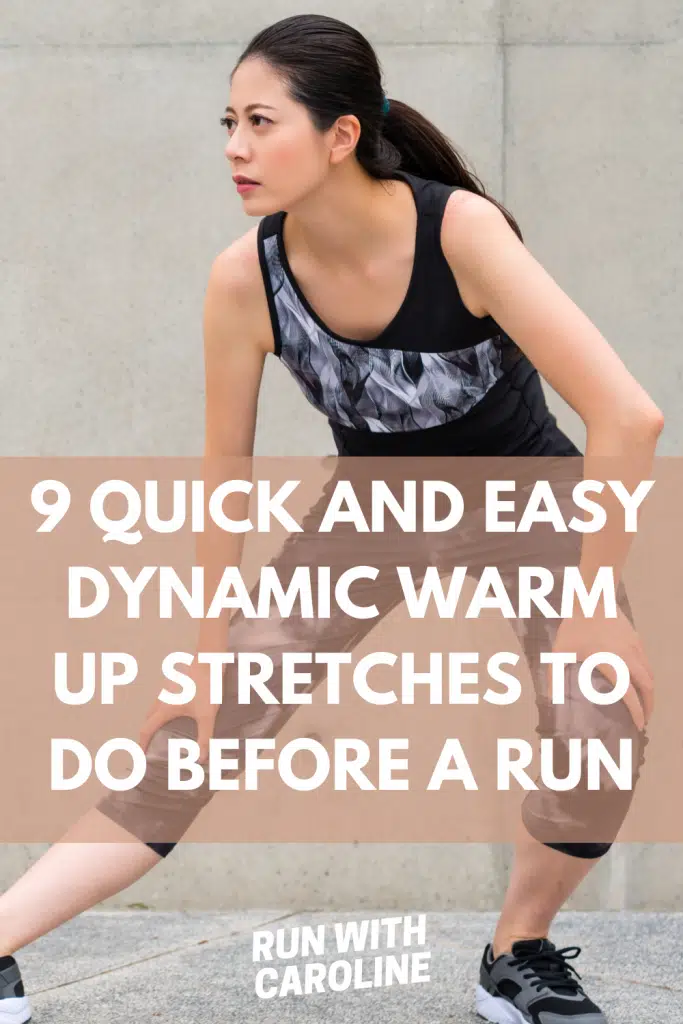The warm up is essential before any run as it prepares your body for the run ahead.
A proper warm up will raise your body temperature and increase blood flow to your muscles, therefore making you less susceptible to injury and muscle soreness after your run.
Dynamic stretching is a key part of a warm up, but unfortunately it is an area that is often overlooked by many runners.
Dynamic stretches for runners like the ones in this guide will go a long way to ensure your body and muscles are warmed up before your run.
These stretches will not only get you physically prepared for your run, but will reduce the risk of common running injuries.
But what exactly is dynamic stretching for runners?
In this guide we’ll look at:
- What is dynamic stretching?
- Static vs dynamic stretching
- Benefits of dynamic stretches for runners
- 9 dynamic stretching examples
Ready?
Let’s get started!

What is dynamic stretching?
If we look at the dynamic definition in the dictionary, it is “a process or system characterized by constant change, activity, or progress.”
Put simply, dynamic stretching up is ‘moving while you stretch’.
This is because dynamic stretching involves constant movement while performing the exercise. In other words, it’s never static.
A dynamic stretch involves stretching through a joint’s full range of motion which helps to encourage blood flow and prevent injury.
Dynamic stretches for runners work by targeting key muscles in your legs, core, arms and shoulders, therefore ensuring all parts of your body are ready to go before your run.
According to a 2015 study, it was found that runners who completed dynamic stretching before a run were better able to sustain hard effort for longer when compared to those who didn’t do a dynamic warm up.
Related: How to warm up before a run: 4 actionable tips
Static vs dynamic stretching
You may be wondering: “What is the difference between static and dynamic stretching?”
The key difference between dynamic stretches and static stretches is how you hold the muscle in the stretch.
Here is a breakdown of each type of stretching:
Dynamic stretches
- Involve active movements to help get your muscles warmed up for exercise
- Stretches are not held for any length of time.
- Target a range of muscles
- Done at the start of a run as part of a warm up
Static stretches
- Involve static stretches that are held for a period of time (normally between 30 to 60 seconds)
- Stretches are fixed and held for a length of time, without movement
- Target a single muscle
- Done at the end of a run as part of a cool down
The key thing to remember is that dynamic stretching should be done as part of a warm up before a run, whereas static stretching should be done as part of a cool down after a run.
Related: 7 of the best glute strengthening exercises for runners

Benefits of dynamic stretches for runners
Dynamic stretching has many benefits for runners when done as part of a warm up before a run:
- Helps to warm up your muscles and joints for exercise
- Reduces risk of injury
- Improves athletic performance
- Increases mobility and flexibility
- Helps to reduce muscle soreness
- Raises your heart rate before a run
A proper warm up will also help to get you physically and mentally prepared for your run.
Your warm up should include light jogging, dynamic stretches and you may also want to consider some running form drills.
Related: Morning stretches for runners: 6 simple moves all runners should do

9 dynamic stretching examples
Now you know about the benefits of dynamic stretches for runners, here are 9 dynamic stretching examples to do before a run.
#1 Leg swings
Leg swings can be done forwards and backwards or side-to-side whilst you face a wall.
They are one of my favourite dynamic stretches for runners because they mobilise your legs, while also working your hip flexors, abductors and adductors.
The leg swing should be a controlled movement with no forced effort.
- Stand with your feet hip width apart and start to swing one leg back and forth while balancing on the other. Hold onto a wall or tree if needed.
- Swing your leg forward and backward 5-10 times.
- Bring your leg down and repeat with the other leg, swinging 5-10 times.
#2 Hamstring sweeps
Hamstring sweeps are great for mobilising your hamstrings which are the key muscles at the back of your upper leg.
Your hamstrings can often feel tight so it’s important to maintain flexibility and mobility to reduce the risk of injury.
- Take a short step forward keeping your heel firmly on the ground.
- Keep your front leg straight and bend your back knee, sinking your bottom towards the ground as though you’re about to sit in a chair.
- At the same time as keeping the front leg straight, sweep down with your hands towards the ground.
- Alternate legs as you walk forwards – each movement should take two to three seconds on each leg.
#3 Deep forward lunge
This is another one of my favourite dynamic stretches for runners as it targets your glutes and hip flexors which can easily become tight and sore when you run regularly.
- Start by standing with your feet together then step your right leg forward and lower down.
- Bend both your knees to a 90 degree angle – your back knee should come close, but never touch the ground.
- Reach towards the ground with your left arm and bring your torso forward over your front leg.
- Hold for three seconds then return by pushing through your right heel and return standing.
- Repeat on the opposite leg. Do 5 reps on each leg.
#4 High skips
High skips are so satisfying to do as part of a warm up.
They are an all-body movement which means they target your legs, arms, shoulders and core.
It’s advisable to do high skips at the end of a warm routine as they can be quite demanding physically.
- Start out by skipping and drive your knee up, whilst remaining in control of the movement (i.e. not flapping your arms).
- Aim to go as far and high on each stride as possible.
- Do them for 15-20 seconds then repeat.
#5 Side shuffles
Side shuffles are great for raising your heart rate, making them one of the best dynamic stretches for runners.
They also target all the key running muscles: calves, hamstrings, glutes and quads. You’ll also find they’ll test your agility and coordination.
- Start by standing with legs straight and arms hanging by your sides.
- Step to the side by doing quick side shuffles.
- Shuffle for 10 to 15 metres then repeat on the other side.
- Keep doing them for about one minute.
#6 Fast feet
This dynamic exercise is great for raising your heart rate before a run, as such I normally do this at the end of a warm up as a finisher.
You will feel the burn in your glutes and quads after this dynamic warm up.
- Start with your feet hip-width apart.
- Sink your bottom towards the ground into a half squat position and reach your arms out in front of you,
- Lift your heels up so you are on the balls of your feet.
- Start running as fast as you can on the spot.
- Stay low as you run.
- Aim to run on the spot for 15-30 seconds.
#7 Arm circles
Arm circles are probably one of the simplest dynamic stretches for runners to do before a run, and yet so beneficial.
They get your arms and shoulders mobilised for your run, which is important as your shoulders can become tight if you’re someone who sits behind a desk all day.
- Stand with your feet shoulder-width apart, arms by your sides.
- Slowly swing your arms forward in a circular motion. You should feel your shoulders loosening up as you do this.
- Continue in a circular motion, then circle the arms in the opposite direction.
- Do 8 reps each direction.
#8 Lateral arm swings
Another great movement to target your chest, arms and shoulders is lateral arm swings.
They are also great for releasing tension in your upper body.
- Stand tall with your feet hip width apart.
- Put both arms straight out in front of you then using your hips and core twist right and left – your outer arm should fold across your chest.
- Keep your arms outstretched and parallel to the ground throughout, but loose and flexible enough at the same time.
- One full rotation is one rep. Do 15-20 reps.
#9 Star touches
Star touches are great to mobilise your arms and shoulders before a run.
- Stand with your feet wider than shoulder-width apart.
- While keeping your legs as straight as possible, reach across your body with your right hand and touch the toes of your left foot.
- Straighten back up to the starting position and repeat on the right side.
- 5 things I wish I’d known before returning to running - March 3, 2024
- Running 20 minutes a day: Benefits + how to start - January 27, 2024
- How to run your first 2 hour half marathon - January 16, 2024
